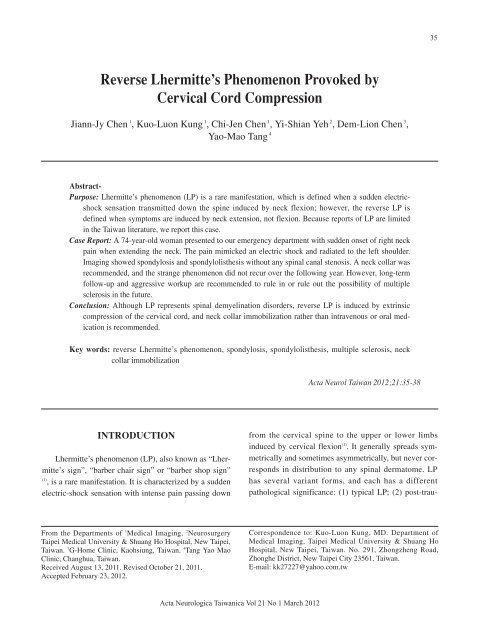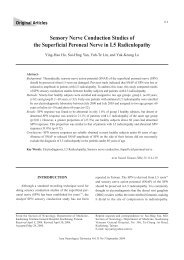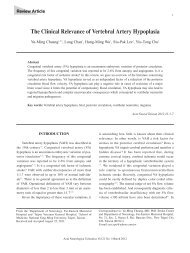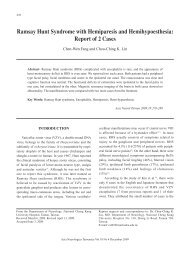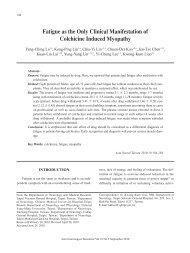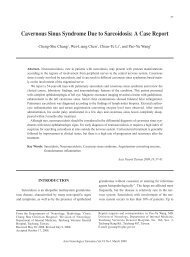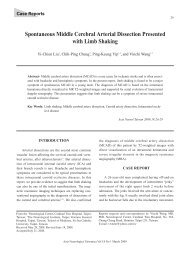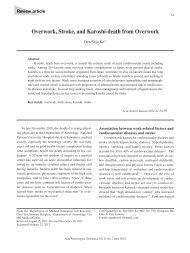Reverse Lhermitte's Phenomenon Provoked by ... - Vol.22 No.1
Reverse Lhermitte's Phenomenon Provoked by ... - Vol.22 No.1
Reverse Lhermitte's Phenomenon Provoked by ... - Vol.22 No.1
Create successful ePaper yourself
Turn your PDF publications into a flip-book with our unique Google optimized e-Paper software.
35<br />
<strong>Reverse</strong> Lhermitte’s <strong>Phenomenon</strong> <strong>Provoked</strong> <strong>by</strong><br />
Cervical Cord Compression<br />
Jiann-Jy Chen 1 , Kuo-Luon Kung 1 , Chi-Jen Chen 1 , Yi-Shian Yeh 2 , Dem-Lion Chen 3 ,<br />
Yao-Mao Tang 4<br />
from the cervical spine to the upper or lower limbs<br />
induced <strong>by</strong> cervical flexion (1) . It generally spreads symmetrically<br />
and sometimes asymmetrically, but never corresponds<br />
in distribution to any spinal dermatome. LP<br />
has several variant forms, and each has a different<br />
pathological significance: (1) typical LP; (2) post-trau-<br />
Abstract-<br />
Purpose: Lhermitte’s phenomenon (LP) is a rare manifestation, which is defined when a sudden electricshock<br />
sensation transmitted down the spine induced <strong>by</strong> neck flexion; however, the reverse LP is<br />
defined when symptoms are induced <strong>by</strong> neck extension, not flexion. Because reports of LP are limited<br />
in the Taiwan literature, we report this case.<br />
Case Report: A 74-year-old woman presented to our emergency department with sudden onset of right neck<br />
pain when extending the neck. The pain mimicked an electric shock and radiated to the left shoulder.<br />
Imaging showed spondylosis and spondylolisthesis without any spinal canal stenosis. A neck collar was<br />
recommended, and the strange phenomenon did not recur over the following year. However, long-term<br />
follow-up and aggressive workup are recommended to rule in or rule out the possibility of multiple<br />
sclerosis in the future.<br />
Conclusion: Although LP represents spinal demyelination disorders, reverse LP is induced <strong>by</strong> extrinsic<br />
compression of the cervical cord, and neck collar immobilization rather than intravenous or oral medication<br />
is recommended.<br />
Key words: reverse Lhermitte’s phenomenon, spondylosis, spondylolisthesis, multiple sclerosis, neck<br />
collar immobilization<br />
Acta Neurol Taiwan 2012;21:35-3821:1-<br />
INTRODUCTION<br />
Lhermitte’s phenomenon (LP), also known as “Lhermitte’s<br />
sign”, “barber chair sign” or “barber shop sign”<br />
(1)<br />
, is a rare manifestation. It is characterized <strong>by</strong> a sudden<br />
electric-shock sensation with intense pain passing down<br />
From the Departments of 1 Medical Imaging, 2 Neurosurgery<br />
Taipei Medical University & Shuang Ho Hospital, New Taipei,<br />
Taiwan. 3 G-Home Clinic, Kaohsiung, Taiwan. 4 Tang Yao Mao<br />
Clinic, Changhua, Taiwan.<br />
Received August 13, 2011. Revised October 21, 2011.<br />
Accepted February 23, 2012.<br />
Correspondence to: Kuo-Luon Kung, MD. Department of<br />
Medical Imaging, Taipei Medical University & Shuang Ho<br />
Hospital, New Taipei, Taiwan. No. 291, Zhongzheng Road,<br />
Zhonghe District, New Taipei City 23561, Taiwan.<br />
E-mail: kk27227@yahoo.com.tw<br />
Acta Neurologica Taiwanica Vol 21 No 1 March 2012
36<br />
matic LP, which follows contusion of the spinal cord<br />
from neck trauma; (3) reverse LP, which is induced <strong>by</strong><br />
extrinsic compression of the cervical spinal cord during<br />
neck extension; (4) inverse LP, which is upward moving<br />
paresthesia induced <strong>by</strong> neck flexion (1) . Because reports of<br />
LP are limited in the Taiwan literature, we report this<br />
case.<br />
CASE REPORT<br />
A 74-year-old woman denied any systemic disease<br />
or history of trauma. She presented to our emergency<br />
department with sudden onset of right neck pain when<br />
extending the neck. The pain mimicked an electric shock<br />
and radiated to the left shoulder. Physical examination<br />
showed a rigid protrusion at the posterior part of the<br />
neck. The muscle power was grade 4 (Medical Research<br />
Council Scale) in the four limbs. Deep tendon reflexes in<br />
all four limbs were symmetrically normal. Both sides of<br />
her body, including the limbs and trunk, were sensitive<br />
to pain on a pinprick test (10/10). There was no neurological<br />
focal sign. Cervical radiographs revealed spondylosis<br />
and grade I anterolisthesis at the C3/4 and C4/5 levels<br />
when she flexed her neck (Fig. 1A, arrow head).<br />
After 30 mg ketoprofen was administrated intravenously,<br />
the strange phenomenon recurred until neck immobilization<br />
was recommended.<br />
She was transferred to our neurosurgical clinic<br />
where computed tomography showed a reversed lordotic<br />
curve of the cervical spine and grade I anterolisthesis at<br />
the C3/4 and C4/5 levels (Fig. 1 B&C, arrows).<br />
Magnetic resonance imaging demonstrated annular<br />
bulging at the 3rd ~ 7th intervertebral discs, causing<br />
mild thecal sac indentation (Fig. 2, dotted circle), but no<br />
spinal canal stenosis. A neck collar was recommended to<br />
immobilize her neck. Over the following year, the radiating<br />
neck pain did not recur, and the muscle power recovered<br />
to grade 5 in the four limbs.<br />
Figure 2. Magnetic resonance imaging, including a T1 fast spin echo<br />
sequence (TR/TE/excitation: 667/11.2/1), T2 fat relaxation<br />
fast spin echo sequence (TR/TE/excitation: 3100/100.7/1),<br />
and T2 fat saturation sequence (TR/TE/excitation:<br />
2933/116.4/1).<br />
DISCUSSION<br />
Figure 1. A: Cervical flexion and extension radiographs. B: Bone<br />
window (W 2,000, C 350) on sagittal computed tomography.<br />
C: Volume rendering on computed tomography.<br />
LP has been used as an eponym demonstrating<br />
ectopic sensory discharges from the mechanical stimulation<br />
of the abnormally excitable demyelinated central<br />
and peripheral sensory axons since 1932 (2) . It was experi-<br />
Acta Neurologica Taiwanica Vol 21 No 1 March 2012
37<br />
enced <strong>by</strong> 33.3 % of 114 patients with multiple sclerosis<br />
in one study, and in 16 % it occurred in the first episode<br />
(3)<br />
. However, it should not be regarded as pathognomonic<br />
of multiple sclerosis because it does occur with various<br />
other conditions affecting the cervical cord and cervicomedullary<br />
junction, such as radiogenic myelopathy (4) ,<br />
trauma (5) , neoplasm (6) and spondylosis/discopathy (7) . In<br />
addition, it can be induced <strong>by</strong> other systemic conditions<br />
such as chemotherapy (8) , vitamin B 12 deficiency (9) , bone<br />
marrow transplantation (10) , Behcet’s disease (11) and herpes<br />
zoster infection (12) . As LP describes a subjective sensation<br />
rather than an objective finding, it would be more<br />
properly designated a symptom than a sign (3) ; besides,<br />
Lhermitte’s syndrome has represented anterior internuclear<br />
ophthalmoplegia, which is a different symptomatology<br />
from LS (13) .<br />
In our case patient, the pain and radiating electric<br />
shock induced <strong>by</strong> neck extension rather than neck flexion;<br />
thus, reverse LP was confirmed. The patient’s neck<br />
flexion radiographs showed more obvious anterolisthesis<br />
than neck extension radiographs in our patient (Fig. 1A);<br />
the computed tomography demonstrated the reverse lordotic<br />
curve of cervical anterolisthesis has distorted the<br />
spinal cord (Fig. 1B), but magnetic resonance imaging<br />
demonstrated thecal sac indentations secondary to<br />
degenerated spine but no evidence of demyelination, and<br />
the cervical structural deformity had not yet compressed<br />
the spinal cord (Fig. 2). We suggested the mechanism of<br />
reverse LP was compression of the cervical spinal cord<br />
<strong>by</strong> the ligamentum flavum in the extension position, not<br />
<strong>by</strong> the listhetic vertebral body in the flexion position (14) ;<br />
besides, the transient cervical spinal cord compression<br />
contributed to the symmetrically decreased muscle<br />
power (grade 4) over both sides.<br />
Unlike that in multiple sclerosis, LP from other<br />
causes is a transient, self-limiting, benign disorder (3) . The<br />
reverse LP in our patient was successfully treated with<br />
neck collar immobilization, so surgery was not recommended.<br />
Possibly, the cervical spinal cord oligodendrocytes<br />
can recover, and myelin synthesis can be resumed,<br />
so that the phenomenon will not recur, and the muscle<br />
power recovered to grade 5 in all limbs. Although the<br />
following year was uneventful, long-term follow-up is<br />
recommended to rule out the possibility of multiple sclerosis<br />
in the future. In conclusion, patients with reverse<br />
LP often concerns about this condition. Neck collar<br />
immobilization rather than intravenous or oral medication<br />
is recommended if cervical cord compression is<br />
impressed.<br />
REFERENCES<br />
1. Kempster PA, Rollinson RD. The Lhermitte phenomenon:<br />
variant forms and their significance. J Clin Neurosci 2008;<br />
15:379-381.<br />
2. Read CF. Multiple sclerosis with Lhermitte’s sign. Arch<br />
Neurol Psychiat 1932;27:227-228.<br />
3. Kanchandani R, Howe JG. Lhermitte’s sign in multiple<br />
sclerosis: a clinical survey and review of the literature. J<br />
Neurol Neurosurg Psychiatry 1982;45:308-312.<br />
4. Lim DC, Gagnon PJ, Meranvil S, Kaurin D, Lipp L,<br />
Holland JM. Lhermitte’s sign developing after IMRT for<br />
head and neck cancer. Int J Otolaryngol 2010;2010:907-<br />
960.<br />
5. Baldwin RN, Chadwick D. Lhermitte’s “sign” due to thoracic<br />
cord compression. J Neurol Neurosurg Psychiatry<br />
1986;49:840-841.<br />
6. Murphy DK, Gutrecht JA. Lhermitte’s sign in cavernous<br />
angioma of the cervical spinal cord. J Neurol Neurosurg<br />
Psychiatry 1998;65:954-955.<br />
7. Signorini GC, Beltramello A, Pinna G, Dalle Ore G. The<br />
significance of preoperative neurological disorders in predicting<br />
outcome of cervical spondylotic myelopathy after<br />
surgery. J Neurosurg Sci 1984;28:89-92.<br />
8. Jurado JM, Pajares B, Olmos D, Sevilla I, Alba E. ‘Out of<br />
blue’ Lhermitte’s sign: three cases due to low cumulative<br />
doses of oxaliplatin. Ann Oncol 2008;19:2093-2094.<br />
9. Teive HA, Haratz S, Zavala J, Munhoz RP, Scola RH,<br />
Werneck LC. Lhermitte’s sign and vitamin B12 deficiency:<br />
case report. Sao Paulo Med J 2009;127:171-173.<br />
10. Wen PY, Blanchard KL, Block CC, Loeffler JS, Davis DG,<br />
Lacroix LA, Antin JH. Development of Lhermitte’s sign<br />
after bone marrow transplantation. Cancer 1992;69:2262-<br />
2266.<br />
11. Page NG, Spiteri MA. Lhermitte’s sign in Behcet’s disease.<br />
Br Med J (Clin Res Ed) 1982;284:704-705.<br />
Acta Neurologica Taiwanica Vol 21 No 1 March 2012
38<br />
12. Vollmer TL, Brass LM, Waxman SG. Lhermitte’s sign in a<br />
patient with herpes zoster. J Neurol Sci 1991;106:153-157.<br />
13. Pearce JM. Jean Lhermitte 1877-1959. J Neurol Neurosurg<br />
Psychiatry 1994;57:846.<br />
14. Koakutsu T, Nakajo J, Morozumi N, Hoshikawa T, Ogawa<br />
S, Ishii Y. Cervical myelopathy due to degenerative<br />
spondylolisthesis. Ups J Med Sci 2011;116:129-132.<br />
Acta Neurologica Taiwanica Vol 21 No 1 March 2012


